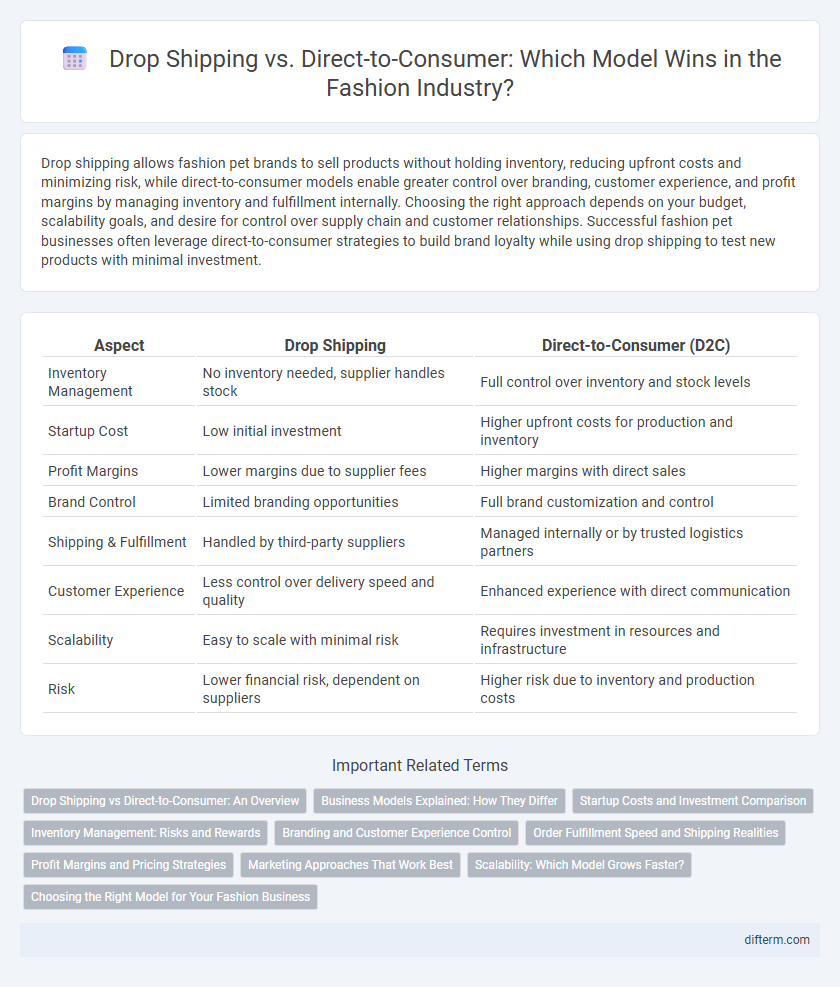Drop shipping allows fashion pet brands to sell products without holding inventory, reducing upfront costs and minimizing risk, while direct-to-consumer models enable greater control over branding, customer experience, and profit margins by managing inventory and fulfillment internally. Choosing the right approach depends on your budget, scalability goals, and desire for control over supply chain and customer relationships. Successful fashion pet businesses often leverage direct-to-consumer strategies to build brand loyalty while using drop shipping to test new products with minimal investment.
Table of Comparison
| Aspect | Drop Shipping | Direct-to-Consumer (D2C) |
|---|---|---|
| Inventory Management | No inventory needed, supplier handles stock | Full control over inventory and stock levels |
| Startup Cost | Low initial investment | Higher upfront costs for production and inventory |
| Profit Margins | Lower margins due to supplier fees | Higher margins with direct sales |
| Brand Control | Limited branding opportunities | Full brand customization and control |
| Shipping & Fulfillment | Handled by third-party suppliers | Managed internally or by trusted logistics partners |
| Customer Experience | Less control over delivery speed and quality | Enhanced experience with direct communication |
| Scalability | Easy to scale with minimal risk | Requires investment in resources and infrastructure |
| Risk | Lower financial risk, dependent on suppliers | Higher risk due to inventory and production costs |
Drop Shipping vs Direct-to-Consumer: An Overview
Drop shipping enables fashion retailers to sell products without maintaining inventory, reducing upfront costs and allowing for a broad product range. Direct-to-consumer (D2C) models involve brands manufacturing and selling products directly to customers, enhancing brand control and customer experience. While drop shipping offers low risk and flexibility, D2C drives higher profit margins and stronger brand loyalty through direct engagement.
Business Models Explained: How They Differ
Drop shipping in fashion relies on third-party suppliers to handle inventory and shipping, minimizing upfront costs and reducing risk. Direct-to-consumer (D2C) involves brands selling products directly to customers, allowing for greater control over branding, customer experience, and profit margins. The primary difference lies in inventory management and customer interaction, with drop shipping offering scalability and lower entry barriers, while D2C emphasizes brand loyalty and personalized consumer relationships.
Startup Costs and Investment Comparison
Drop shipping requires minimal startup costs, as it eliminates inventory purchase and warehousing expenses, making it ideal for fashion startups with limited budgets. Direct-to-consumer (DTC) models demand higher initial investments in product manufacturing, inventory, and fulfillment infrastructure, but offer greater control over branding and customer experience. Comparing investment, drop shipping offers lower financial risk while DTC requires significant capital but can achieve higher profit margins in the competitive fashion market.
Inventory Management: Risks and Rewards
Drop shipping in fashion minimizes inventory risks by eliminating the need to hold stock, allowing brands to offer diverse product lines without upfront investment. Direct-to-consumer models require careful inventory management to avoid overstock or stockouts, but they enable better control over product quality and brand experience. Efficient inventory tracking systems enhance profitability by balancing supply with customer demand in both strategies.
Branding and Customer Experience Control
Drop shipping limits branding opportunities as products are shipped directly from suppliers, reducing control over packaging and customer interactions. Direct-to-consumer (DTC) models enable brands to customize packaging, deliver personalized messages, and create a cohesive shopping experience that strengthens brand identity. Enhanced control over customer experience in DTC increases loyalty and allows for better feedback integration to improve products and services.
Order Fulfillment Speed and Shipping Realities
Dropshipping in fashion often results in slower order fulfillment due to reliance on third-party suppliers and longer shipping times from international locations. Direct-to-consumer brands benefit from faster order processing and reliable domestic shipping, enhancing customer satisfaction and reducing return rates. Realities of global logistics impact dropshipping more significantly, making direct-to-consumer models preferable for speed and shipping transparency.
Profit Margins and Pricing Strategies
Drop shipping offers lower upfront costs and reduced inventory risks but typically results in thinner profit margins due to supplier fees and less control over pricing. Direct-to-consumer (DTC) models allow brands to set premium prices by owning the customer experience and eliminating middlemen, leading to higher profit margins and stronger brand loyalty. Effective pricing strategies in DTC leverage data analytics and customer insights, while drop shipping relies heavily on competitive pricing to attract cost-sensitive consumers.
Marketing Approaches That Work Best
Drop shipping relies heavily on digital marketing strategies like social media ads and influencer partnerships to drive immediate sales without inventory investment. Direct-to-consumer (DTC) brands benefit from building strong customer relationships through personalized email campaigns, loyalty programs, and authentic brand storytelling that fosters long-term engagement. Both approaches require targeted content marketing and data-driven advertising to optimize conversion rates in the competitive fashion industry.
Scalability: Which Model Grows Faster?
Drop shipping enables rapid scalability by minimizing inventory risks and upfront costs, allowing fashion brands to quickly test trends and expand product lines globally without warehouse constraints. Direct-to-consumer (DTC) models offer greater control over branding and customer experience, often resulting in higher profit margins and stronger customer loyalty, but require significant investment in inventory and infrastructure to scale. Fashion brands aiming for rapid market penetration may prefer drop shipping, while those focused on building a sustainable, scalable brand often lean toward DTC for long-term growth.
Choosing the Right Model for Your Fashion Business
Selecting the right model between drop shipping and direct-to-consumer (DTC) hinges on factors like inventory control, profit margins, and customer experience. Drop shipping minimizes upfront investment and inventory risk but often yields lower margins and less brand control, making it ideal for startups testing market demand. The DTC model offers higher profit potential and full control over branding and customer engagement, suitable for established fashion businesses prioritizing quality and customer loyalty.
Drop shipping vs direct-to-consumer Infographic

 difterm.com
difterm.com